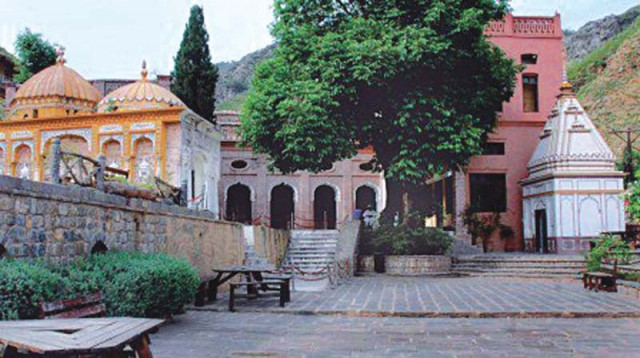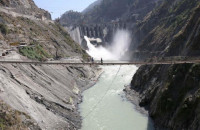Saidpur village struggles against decay
Historic village falls victim to commercialisation, encroachments

Reeking piles of garbage have become the hallmarks of the historic Saidpur village deterring regular visitors and leading minorities to believe that their religious sites are insignificant.
An icon of the federal capital’s ancient heritage, Saidpur Village, located in the Margalla Hills, has in recent times fallen victim to commercialization and due to the lack of proper maintenance is a distant image of the garden resort it used to be in prehistoric times.
Its visitors who found serenity in its natural ponds and areas surrounding the Hindu temple now complain of the foul smell that lingers throughout the village.
Yun Woo, a Chinese resident of the capital, who frequents the village every Sunday to escape from the din of central Islamabad, despondently told the Express Tribune that the condition of the cultural heritage is deteriorating rapidly especially due to environmental pollution, poor management, and lack of preservation and restoration.
“Perhaps, if they put up an information board at the entrance of the temple describing the history of the village and its significance, people would take care of it better,” Woo suggested. Saidpur’s historical significance is such that it was mentioned in the Tuzk-e-Jahangiri, a book by the Mughal emperor Jahangir, as per Dr Abdul Ghafoor Lone, an official of the Directorate of Archaeology and Museums.
Dr Lone, whilst delving into Saidpur’s origin story which dates back to 1530 A.D., informed that available literature states that the Mughal Raja Man Singh was smitten with the place when he visited in 1580. “Raja Man Singh was so enamored by the village that he turned it into a place of religious worship. He constructed raised platforms, walled enclosures and a number of kunds [ponds] called Rama kunda, Sita kunda, Lakshaman kunda, and Hanuman kunda.”
According to official sources, CDA declared Saidpur as an “Arts and Craft Village” back in 2006, in a bid to preserve its centuries-old cultural heritage as well as promote tourism and has so far spent Rs 400 million on the preservation and restoration of the village.
However, despite the money spent the temple is in a state of ruin and the ponds have now given way to water from sewers and are unpleasant to even stand around due to the putrid smell. “Although the white in the national flag represents minorities, the reality is different as our worship places face lack of preservation and the temple in this village is ample proof of this,” said Meena Kumari, a resident of Lalkurti, Rawalpindi, who was visiting the village with a tour bus and was left disappointed with what she saw.
Kumari, directing her ire toward local authorities said, “the temple’s electricity has been disconnected since the last time I visited two years ago. The locals are dumping their garbage around the building. However, the biggest insult is that our deities have been removed from the temple.” Ruth Gill, another visitor among the group of ladies, was similarly disappointed, urging that the Evacuee Trust Property Board, Pakistan Hindu Council, Capital Development Authority (CDA), and Ministry of Minorities Affairs should join hands to save the temple for the twin cities’ Hindus.
Gill, reiterating Woo’s suggestion, told the Express Tribune that information boards should be put up at every building depicting the history, significance and importance of each building in the village.



















COMMENTS
Comments are moderated and generally will be posted if they are on-topic and not abusive.
For more information, please see our Comments FAQ